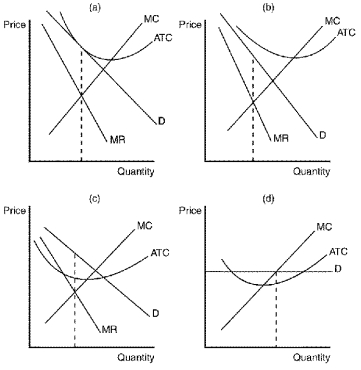Correct Answer

verified
Correct Answer
verified
Multiple Choice
Two bottles of body wash sit side-by-side in a grocery store: Olay (a brand name) sells for $6.00,while Up and Up (not a brand name) sells for $3.00.Even defenders of brand names would have to admit that
A) no rational consumer would spend twice as much for Olay as she would for Up and Up.
B) the side-by-side presence of these two body washes conveys no useful information to consumers.
C) Olay has no incentive to maintain the quality of its product just because of the Olay brand name.
D) None of the above is correct.
Correct Answer

verified
Correct Answer
verified
Multiple Choice
When a profit-maximizing firm in a monopolistically competitive market charges a price higher than marginal cost,
A) the firm must be earning a positive economic profit.
B) the firm may be incurring economic losses
C) there is a deadweight loss to society, but it is exactly offset by the benefit of excess capacity.
D) new firms will enter the market in the long run.
Correct Answer

verified
Correct Answer
verified
Multiple Choice
In a long-run equilibrium,
A) only a perfectly competitive firm operates at its efficient scale.
B) only a monopolistically competitive firm operates at its efficient scale.
C) neither a competitive firm nor a monopolistically competitive firm charges a markup over marginal cost.
D) both a perfectly competitive firm and a monopolistically competitive firm operate at their efficient scale of production.
Correct Answer

verified
Correct Answer
verified
Multiple Choice
Which of the following is unique to a monopolistically competitive firm when compared to an oligopoly?
A) The monopolistically competitive firm advertises.
B) The monopolistically competitive firm produces a quantity of output that falls short of the socially optimal level.
C) Monopolistic competition features many buyers.
D) Monopolistic competition features many sellers.
Correct Answer

verified
Correct Answer
verified
True/False
Monopolistic competition and monopoly are examples of a market structure called imperfect competition.
Correct Answer

verified
Correct Answer
verified
Multiple Choice
Which of the following is an example of a monopolistically competitive industry?
A) breakfast cereals
B) cigarettes
C) restaurants in New York City
D) milk
Correct Answer

verified
Correct Answer
verified
Multiple Choice
Table 16-1
The following table shows the percentage of output supplied by the top eight firms in four different industries.
 -Refer to Table 16-1.Which industry is the most competitive?
-Refer to Table 16-1.Which industry is the most competitive?
A) Industry W
B) Industry X
C) Industry Y
D) Industry Z
Correct Answer

verified
Correct Answer
verified
Multiple Choice
Table 16-4
This table shows the demand schedule, marginal cost, and average total cost for a monopolistically competitive firm.
 -Refer to Table 16-4.If the government forces this firm to produce at its efficient output level,how much profit will this firm earn?
-Refer to Table 16-4.If the government forces this firm to produce at its efficient output level,how much profit will this firm earn?
A) a $4 loss
B) a $6 loss
C) a $6 profit
D) a $12 profit
Correct Answer

verified
Correct Answer
verified
Multiple Choice
The traditional view of monopolistic competition holds that this type of industrial structure is inefficient because
A) there are too few firms to reach an efficient level of production.
B) firms do not operate at the output that minimizes average costs.
C) more advertising is needed to inform customers about product differences.
D) consumers do not have enough choice among the product varieties available.
Correct Answer

verified
Correct Answer
verified
Multiple Choice
Figure 16-4
 -Refer to Figure 16-4.Which of the graphs depicts a short-run equilibrium that will encourage the exit of some firms from a monopolistically competitive industry?
-Refer to Figure 16-4.Which of the graphs depicts a short-run equilibrium that will encourage the exit of some firms from a monopolistically competitive industry?
A) panel a
B) panel b
C) panel c
D) panel d
Correct Answer

verified
Correct Answer
verified
True/False
Monopolistic competition is characterized by many buyers and sellers,product differentiation,and barriers to entry.
Correct Answer

verified
Correct Answer
verified
Multiple Choice
When a market is monopolistically competitive,the typical firm in the market can earn
A) losses in the short run and profits in the long run.
B) profits in the short run and the long run.
C) losses in the short run and zero profit in the long run.
D) zero profit in the short run and losses in the long run.
Correct Answer

verified
Correct Answer
verified
Multiple Choice
When quality cannot be easily judged in advance,what provides consumers with information about the quality of a product?
A) a brand name
B) a tie-in
C) the quantity available for sale
D) the amount of deadweight loss
Correct Answer

verified
Correct Answer
verified
Multiple Choice
A monopolistically competitive market
A) usually has too many firms, reducing the economic profit of each firm to zero.
B) usually has too few firms, reducing the product variety for consumers.
C) may have too many or too few firms, and the government can intervene to achieve the optimal number of firms.
D) may have too many or too few firms, but the government can do little to rectify the situation.
Correct Answer

verified
Correct Answer
verified
Multiple Choice
Table 16-4
This table shows the demand schedule, marginal cost, and average total cost for a monopolistically competitive firm.
 -Refer to Table 16-4.How much profit will this firm earn when it chooses its output to maximize profit?
-Refer to Table 16-4.How much profit will this firm earn when it chooses its output to maximize profit?
A) a $4 loss
B) a $2 loss
C) a $6 profit
D) a $16 profit
Correct Answer

verified
Correct Answer
verified
Multiple Choice
Which of the following goods are likely to be sold in a monopolistically competitive market?
A) sweaters
B) cola
C) corn
D) postage stamps
Correct Answer

verified
Correct Answer
verified
Multiple Choice
Roberto consumes Coke exclusively.He claims that there is a clear taste difference and that competing brands of cola leave an unsavory taste in his mouth.In a blind taste test,Roberto is found to prefer Coke to store-brand cola eight out of ten times.The results of Roberto's taste test would refute claims by critics of brand names that
A) consumers are always willing to pay more for brand names.
B) brand names cause consumers to perceive differences that do not really exist.
C) consumers with the lowest levels of income are the most likely to be influenced by brand name advertising.
D) brand names are a form of socially efficient advertising.
Correct Answer

verified
Correct Answer
verified
Multiple Choice
In which of the following market structures can firms earn economic profits in the long run?
A) perfect competition
B) monopolistic competition
C) monopoly
D) Both b and c are correct.
Correct Answer

verified
Correct Answer
verified
Multiple Choice
Product differentiation in monopolistically competitive markets ensures that,for profit-maximizing firms,
A) marginal revenue will equal average total cost.
B) price will exceed marginal cost.
C) marginal cost will exceed average revenue.
D) average variable cost will be declining.
Correct Answer

verified
Correct Answer
verified
Showing 321 - 340 of 497
Related Exams